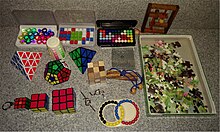Puzzle
| Part of a series on |
| Puzzles |
|---|
 |
A puzzle is a
Puzzles are often created to be a form of entertainment but they can also arise from serious
Etymology
The
The etymology of the verb puzzle is described by OED as "unknown"; unproven hypotheses regarding its origin include an Old English verb puslian meaning 'pick out', and a derivation of the verb pose.[3]
Genres


Puzzles can be categorized as:
- Lateral thinking puzzles, also called "situation puzzles"
- Mathematical puzzles include the missing square puzzle and many impossible puzzles — puzzles which have no solution, such as the Seven Bridges of Königsberg, the three cups problem, and three utilities problem
- Sangaku (Japanese temple tablets with geometry puzzles)
- A chess problem is a puzzle that uses chess pieces on a chess board. Examples are the knight's tour and the eight queens puzzle.
- Mechanical puzzles or dexterity puzzles such as the Rubik's Cube and Soma cube can be stimulating toys for children or recreational activities for adults.
- combination puzzles like Peg solitaire
- construction puzzles such as stick puzzles
- disentanglement puzzles,
- folding puzzles
- jigsaw puzzles. Puzz 3D is a three-dimensional variant of this type.
- lock puzzles
- A jewelry, for instance.
- 15 Puzzle and Sokoban
- tiling puzzles like Tangram
- Tower of Hanoi
- Metapuzzles are puzzles which unite elements of other puzzles.
- Paper-and-pencil puzzles such as Uncle Art's Funland, connect the dots, and nonograms
- Also the .
- Spot the difference
- Tour puzzles like a maze
- Wheel of Fortune (U.S. game show)is a game show centered on a word puzzle.
- Puzzle video games
- Tile-matching video game
- Puzzle-platformer
- Adventure game
- Hidden object game
- Minesweeper
Puzzle solving
This section possibly contains original research. (November 2018) |
Solutions of puzzles often require the recognition of
Puzzle makers
Puzzle makers are people who make puzzles. In general terms of occupation, a puzzler is someone who composes and/or solves puzzles.
Some notable creators of puzzles are:
- Ernő Rubik
- Sam Loyd
- Henry Dudeney
- Boris Kordemsky
- David J. Bodycombe
- Will Shortz
- Oskar van Deventer
- Lloyd King
- Martin Gardner
- Raymond Smullyan
History of jigsaw and other puzzles
After becoming popular among the public, this kind of teaching aid remained the primary use of jigsaw puzzles until about 1820.[6]
The largest puzzle (40,320 pieces) is made by a German game company Ravensburger.[7] The smallest puzzle ever made was created at LaserZentrum Hannover. It is only five square millimeters, the size of a sand grain.
The puzzles that were first documented are
By the early 20th century, magazines and newspapers found that they could increase their readership by publishing
Organizations and events
There are organizations and events that cater to puzzle enthusiasts, such as:
- Nob Yoshigahara Puzzle Design Competition
- World Puzzle Championship
- National Puzzlers' League
- National Puzzle Day
- Puzzlehunts such as the Maze of Games
- World Cube Association
See also
- List of impossible puzzles
- List of Nikoli puzzle types– Japanese puzzle publisher and magazine
- Riddle – Statement with a double meaning used as a puzzle
References
- ^ Kendall G.; Parkes A.; and Spoerer K. (2008) A Survey of NP-Complete Puzzles, International Computer Games Association Journal, 31(1), pp 13–34.
- ^ "puzzle, n." OED Online. Oxford University Press, December 2019. Web. 21 January 2020.
- ^ "puzzle, v." OED Online. Oxford University Press, December 2019. Web. 21 January 2020.
- ^ Wilson, R. "Sudoka Number Game". Encyclopedia Britannica. Retrieved 21 June 2022.
- ^ "History of Puzzles | PuzzleWarehouse.com". www.puzzlewarehouse.com. Retrieved 2019-11-20.
- ^ History of Jigsaw Puzzles Archived 2014-02-11 at the Wayback Machine The American Jigsaw Puzzle Society
- ^ "The worlds biggest Puzzle | Ravensburger". www.ravensburger.us. Retrieved 2018-06-23.
- ^ "A Brief History of Puzzles". Puzzle Museum. 6 April 2017. Archived from the original on 14 April 2020.
Further reading
- van Delft, Pieter; Botermans, Jack (1978). Creative puzzles of the world. Cassell. ISBN 978-0-304-30300-7.
External links
